Angela Ackerman's Blog: Writers Helping Writers, page 34
August 5, 2023
Character Type & Trope Thesaurus: Snob
In 1959, Carl Jung first popularized the idea of archetypes���”universal images that have existed since the remotest times.” He posited that every person is a blend of these 12 basic personalities. Ever since then, authors have been applying this idea to fictional characters, combining the different archetypes to come up with interesting new versions. The result is a sizable pool of character tropes that we see from one story to another.
Archetypes and tropes are popular storytelling elements because of their familiarity. Upon seeing them, readers know immediately who they’re dealing with and what role the nerd, dark lord, femme fatale, or monster hunter will play. As authors, we need to recognize the commonalities for each trope so we can write them in a recognizable way and create a rudimentary sketch for any character we want to create.
But when it comes to characters, no one wants just a sketch; we want a vibrant and striking cast full of color, depth, and contrast. Diving deeper into character creation is especially important when starting with tropes because the blessing of their familiarity is also a curse; without differentiation, the characters begin to look the same from story to story.
But no more. The Character Type and Trope Thesaurus allows you to outline the foundational elements of each trope while also exploring how to individualize them. In this way, you’ll be able to use historically tried-and-true character types to create a cast for your story that is anything but traditional.
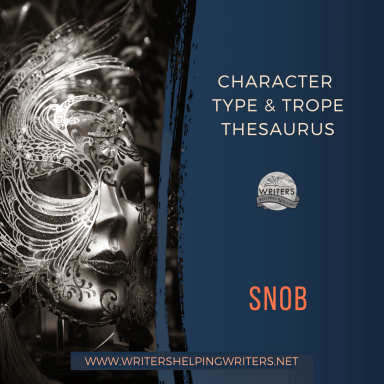 Snob
SnobDESCRIPTION: Snobs look down on people below their own social or financial station. They often display an exaggerated sense of elitism and condescension because they believe they’re superior in some way.
FICTIONAL EXAMPLES: The Malfoys (the Harry Potter series), Lady Catherine de Bourgh (Pride and Prejudice), Tom Buchanan (The Great Gatsby), Regina George (Mean Girls), Frasier and Niles Crane (Frasier)
COMMON STRENGTHS: Ambitious, Centered, Charming, Confident, Meticulous, Passionate, Proper, Sophisticated
COMMON WEAKNESSES: Catty, Cruel, Fussy, Gossipy, Haughty, Humorless, Inflexible, Judgmental, Know-It-All, Materialistic, Nosy, Prejudiced, Pretentious, Self-Indulgent, Spoiled, Vain
ASSOCIATED ACTIONS, BEHAVIORS, AND TENDENCIES
Having a strong sense of personal identity
Not being easily swayed by the opinions of others
Paying meticulous attention to detail
Dressing stylishly
Being self-possessed and appearing confident
Being driven to achieve greater success and importance through self-development
Having discerning tastes
Having a deep understanding about their area of interest���art, fashion, literature, or even more mundane things, like coffee or wine
Associating with people they believe are worthy of their attention
Indulging in extravagant displays of wealth or personal achievement
Putting others down���publicly or privately���because of a lack of personal taste
Having a superiority complex
Believing their friends or wealth makes them worthier or more respected than others
Ensuring everyone around them knows how smart or accomplished they are
Dropping names
Attaching themselves to people who can improve their status
Gathering sycophants and groupies
Expounding on their opinion whenever possible
Excelling at finding weak spots and attacking them
Perfectionism
Sucking up to others; brownnosing
Congregating with other snobs who share their interests
SITUATIONS THAT WILL CHALLENGE THEM
Being linked with someone the character deems as being inferior
Someone the character views as unworthy achieving status greater than their own
Someone they admire behaving like a snob toward them
Dismissing someone, then later discovering they have greater skill, wealth, or knowledge than the character
Facing consequences for their snobbish behavior that threaten the pursuit of their goals
Being doubted by their peers or ousted from an elite group
INNER STRUGGLES TO GIVE THEM DEPTH
Realizing their achievements haven’t brought them happiness
Acting confident while struggling with deep insecurity
Being drawn to someone they consider to be beneath them
Being snobbish to gain the approval of a parent or mentor, then despising themselves for it
Struggling with imposter syndrome regarding an area of supposed expertise
TWIST THIS TROPE WITH A CHARACTER WHO���
Is outwardly confident but privately reveals their vulnerabilities to someone they trust and respect
Has a hidden talent or passion that defies their snobbish persona���i.e., raising money for an impoverished neighborhood because it’s where they came from
Intentionally uses the isolation caused by their elitism to keep their humanitarian efforts secret
Is a snob despite not meeting the usual criteria (they’re poor, live in an undesirable area, etc.)
Is snobbish about unconventional things, such as rugby or country music
Has an atypical trait: childish, simple, whimsical, empathetic, rowdy, etc.
CLICH��S TO BE AWARE OF
A prep school student whose self-worth is solely defined by displays of status
A snob who has loyal groupies despite constantly belittling them
A food critic with an exaggerated accent who makes a point of tearing down aspiring restaurateurs
A bully whose deeper motivations, fears, and insecurities are never explored, making the character flat and cartoon-like
A snob who is an expert on expected topics, such as wine, the opera, and modern art
Other Type and Trope Thesaurus entries can be found here.
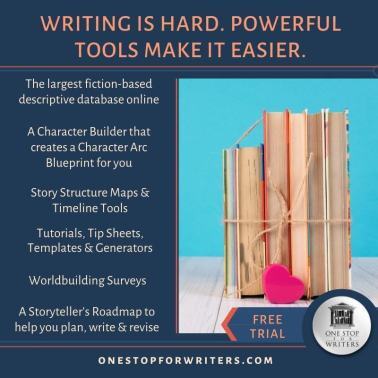 Need More Descriptive Help?
Need More Descriptive Help?While this thesaurus is still being developed, the rest of our descriptive collection (16 unique thesauri and growing) is accessible through the One Stop for Writers THESAURUS database.
If you like, swing by and check out the video walkthrough for this site, and then give our Free Trial a spin.
The post Character Type & Trope Thesaurus: Snob appeared first on WRITERS HELPING WRITERS��.
August 3, 2023
Five Commonalities Between Heroes and Villains
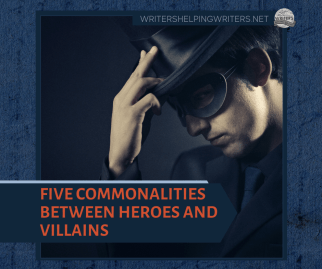
In story terms, a villain is a person, entity, or force who is cruel, evil, or malicious enough to wish the protagonist harm. Rather than simply blocking a goal or interfering with the hero���s plan, a villain causes suffering, making it vital for them to be conquered by the protagonist. Clarice must find and defeat Buffalo Bill if she wants to rise above her past and become a great FBI agent (The Silence of the Lambs); Chief Brody must kill the man-eating shark to preserve his town (Jaws).
Regardless of the form your villain takes, there are certain qualities that will make them formidable and credible���qualities and connections they share with the protagonist. Let���s explore these qualifications through a case study of Dr. Lawrence Myrick, played by Gene Hackman in the movie Extreme Measures.
Villains, Like Heroes, Live By A Moral Code
It���s been said that the best villains don���t know they���re villains; they think they���re the hero of the story. And this is true because a well-crafted baddie has his own moral code. Compared to the protagonist���s, it���s twisted and corrupt, but it still provides guardrails that guide him through the story.��
Dr. Myrick is a renowned and brilliant neurosurgeon who has dedicated his life���s work to curing paralysis. It���s a noble cause that he believes in more than anything���not so much for himself but for all the paralyzed people in the world. This cause is so important that when he develops a treatment, he can���t wait decades for it to crawl through the testing process and eventually be approved. So he bypasses the animal testing phase and goes right to human trials. It���s kind of hard to find healthy subjects who are willing to take such a risk, so he kidnaps homeless people and confines them to his secret medical facility, then severs their spinal cords so he can test his treatment on them.
To the rest of the world, this is unconscionable. But to Myrick, the end justifies the means. He���s perfectly okay stealing people, taking away their freedom and mobility, and subjecting them to countless medical cruelties. And if they reach a point of no longer being useful, he���s fine doing away with them because they���re people no one will miss. He actually views them as heroes, sacrificing themselves for the greater good. His morals are deranged, but they���re absolute, guiding his choices and actions. And when you know his code, while you don���t agree with it, you at least understand what���s driving him, and his actions make sense.
When you���re planning your villain, explore their beliefs about right and wrong. Figure out their worldview and ideals. Specifically, see how the villain���s beliefs differ from the protagonist���s. This will show you the framework the villain is willing to work within, steer the conflict they generate, and provide a stark contrast to the hero.
They Have A Story Goal, TooLike the hero, the villain has an overall objective, and they���re willing to do anything within their moral code to achieve it. When their goal is diametrically opposed to the hero���s, the two become enemies in a situation where only one can succeed.
We know Myrick���s goal: to cure paralysis. And things are progressing nicely until an ER doctor in his hospital discovers homeless patients disappearing from the facility. Dr. Lathan starts nosing around, and when he realizes someone is up to no good, it becomes his mission to stop them. So the two are pitted against each other. If one succeeds, the other must fail. To quote Highlander: there can only be one.
As the author who has spirited the villain out of your own (dare we say twisted?) imagination, you need to know their goal. It should be as clear-cut and obvious as the hero���s objective. Does it put them in opposition to the protagonist? Ideally, both characters��� goals should block each other from getting what they want and need.
Villains Are Well-Rounded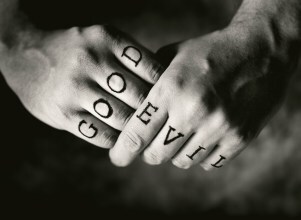
Because villains are typically evil, it���s easy to fill them up with flaws and forget the positive traits. But good guys aren���t all good and bad guys aren���t all bad, and characters written this way have as much substance as the flimsy cardboard they���re made of. Myrick is cruel, unfeeling, and devious. But he���s also intelligent, generous, and absolutely dedicated to curing a devastating malady that afflicts the lives of many.
Positive traits add authenticity for the villain while making them intimidating and harder to defeat. An added bonus is when their strength counters the hero���s.
The villain of Watership Down is General Woundwort, a nasty rabbit whose positive attributes are brute strength and sheer force of will, making him more man than animal. In contrast, hero Hazel embodies what it means to be a rabbit. He���s swift and clever. He knows who he is and embraces what makes him him. In the end, Hazel and his rabbits overcome a seemingly undefeatable enemy by being true to their nature.
When your villain is conceived and begins to grow in the amniotic fluid of your imagination, be sure to give him some positive traits along with the negative ones. Not only will you make him an enemy worthy of your hero, he���ll also be one readers will remember.��
They Have A Backstory(And You Know What It Is)��
Authors know how important it is to dig into their protagonist���s backstory and have a strong grasp of how it has impacted that character. Yet one of the biggest mistakes we make with villains is not giving them their own origin story. A character who is evil with no real reason behind their actions or motivations isn���t realistic, making them stereotypical and a bit…meh.
To avoid this trap, know your villain���s beginnings. Why are they the way they are? What trauma, genetics, or negative influencers have molded them into their current state? Why are they pursuing their goal���what basic human need is lacking that achieving the goal will satisfy? The planning and research for this kind of character is significant, but it will pay off in the form of a memorable and one-of-a-kind villain who will give your hero a run for his money and intrigue readers.
They Share A Connection With The ProtagonistIn real life, we have many adversaries. Some of them are distant���the offensive driver on the highway or that self-serving, flip-flopping politician you foolishly voted for. Those adversaries can create problems for us, but the ones that do the most damage���the ones we find hardest to confront���are those we share a connection with. Parents, siblings, exes, neighbors we see every day, competitors we both admire and envy, people we don���t like who are similar to us in some way…conflicts with these people are complicated because of the emotions they stir up.
The same is true for our protagonists. The most meaningful clashes will be with the people they know. Use this to your advantage. Bring the villain in close and make things personal by engineering a connection between the two characters. Here are a few options for you to work with.
Give Them a Shared History. The more history the two have, the more emotion will be involved. Guilt, rage, grief, fear, jealousy, regret, desire���strong feelings like these will add sparks to their interactions. They���ll cloud the protagonist���s judgment and increase the chances their villain will gain an edge. Make Them Reflections of Each Other. What happens when the protagonist sees him or herself in the villain? A seed of empathy forms. The hero feels a connection with the person they have to destroy, which complicates things immensely. Personality traits, flaws, vulnerabilities, wounding events, needs and desires���all of these (and more) can be used to forge a bond that will add complexity and depth to this important relationship. Give Them a Shared Goal. When your hero and your villain are pursuing the same objective, it accomplishes a number of good things. First, it ensures that only one of them can be the victor, pitting them against each other. But they���re also more likely to understand one another. They���ll have different reasons and methods of chasing the dream, but the shared goal can create an emotional connection.As you can see, a lot goes into creating an enemy that is realistic, complete, and worthy of holding the title of villain in your story. When you���re drawing this character, give them the same thought and effort you���d put into your hero, and you���ll end up with a villain that will enhance your story, intrigue readers, and give the hero a run for their money.��
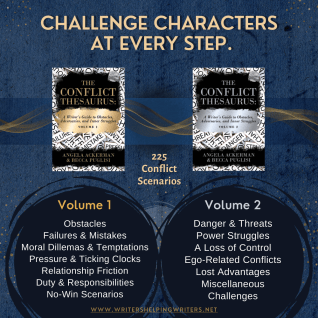 Want to take your
Want to take your conflict further?��
The Conflict Thesaurus: A Writer’s Guide to Obstacles, Adversaries, and Inner Struggles (Volume 1 & Volume 2) explores a whopping 225 conflict scenarios that force your character to navigate relationship issues, power struggles, lost advantages, dangers and threats, moral dilemmas, failures and mistakes, and much more!
The post Five Commonalities Between Heroes and Villains appeared first on WRITERS HELPING WRITERS��.
August 1, 2023
How to Stay Focused on Your Story���s Central Conflict��
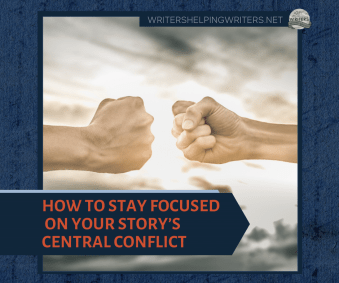
Conflict in every scene.
We���ve all heard this advice, and for good reason. Your protagonist has a goal���hopefully, an audacious and high-stakes goal that is difficult to achieve. ���Difficult��� is important. It���s one of the qualities of a highly engaging story because the harder the goal is to reach, the less certainty readers have that the protagonist will be ok. They���ll find themselves wondering: Will the hero win in the end? Can they overcome the odds? Will they be able to make the necessary internal growth for them to succeed?
To maintain this level of reader empathy and engagement, the conflict has to come hard and fast���there needs to be hardship in every single scene. Some of that strife will relate directly back to the story goal in the form of obstacles, adversaries, setbacks, and disappointments that push the character farther from their objective.
But not every conflict has to do with the overall goal. Some of it relates to an important subplot that���s impacting a key story player. And then you have inner conflict, which exists solely within the character as they struggle with various aspects of personal evolution and internal growth.
As you���re drafting���as the story progresses and the protagonist’s difficulties compound���there’s always a risk of the central conflict getting muted or lost in the noise. Too much conflict, or certain problems getting a disproportionate chunk of airtime, can lead to pacing issues and confused readers who aren���t sure what the character is working toward. Keeping the core plot and central conflict as your main focus is the best way to ensure that everything you add to the story is leading to that eventual climax.
How do we do that exactly?
Know Your Story���s Central ConflictThe first step is to identify the main conflict for your story. A good place to start is with the six common literary forms of conflict:
Character vs. Character: In this scenario, the protagonist goes head-to-head with another character in a battle of wills. (Harry Potter and the Sorcerer���s Stone, Die Hard, The Princess Bride)Character vs. Society: These stories feature a character who faces seemingly insurmountable challenges when taking on society or a powerful agency within their world. (The Hunger Games, Schindler���s List, Erin Brockovich)Character vs. Nature: In this case, the character goes up against nature. (The Perfect Storm, Wild, The Revenant)Character vs. Technology: This conflict will pit a character against technology or a machine. (The Terminator, The Matrix, WarGames)Character vs. Supernatural: This form of conflict involves a character facing opposition that exists (at least partially) outside their understanding. (Dr. Sleep, Ghost Rider, Percy Jackson and the Olympians)Character vs. Self: Of all the conflict forms, this is the most personal (and often the most compelling) because the friction arises from within the character���s belief system or personal identity. (The Bourne Identity, Dexter, A Beautiful Mind)
Which of the six central conflicts is your story built around? Identifying it will help you keep it front-of-mind and in the spotlight. This knowledge can also help you choose the right conflict scenarios���the problems and friction-inducing situations that will test your character���s commitment, reveal characterization, and force them to reflect on how to become stronger so they can achieve their goal.
Once you���ve zeroed in on the main conflict for your story, you can keep an eagle eye on the other hardships that, if you���re not careful, can become larger-than-life and overpower your main plotline.
Character Arc ConflictWhen a character resolves their main internal struggle, their heart and mind become aligned, which is usually necessary for them to achieve their goal. It���s no surprise then that inner conflict tied to the character���s arc will be prominent. However, just because it���s crucial to your story doesn���t mean internal tug-of-wars should overwhelm everything else, including your plot.
In this case, balancing internal and external conflict is all about proportion: including enough internal struggle to show the character’s gradual journey toward change without bogging down the external plot and related conflict. This is handled quite well in the first book of the Harry Potter series.

As Rowling introduces readers to Harry and his world in the opening pages, she focuses largely on external conflict: the Dursleys belittle Harry, lock him in a cupboard, withhold his mail, and motor him off to an isolated island to keep him from getting his Hogwarts letter. Then Hagrid appears and turns his world upside down.
Here’s where we see the first real internal conflict from Harry. It’s fitting, because one thing he’s learned from living with the Dursleys is to keep his head down and avoid attention. So he rolls with the punches, taking whatever’s thrown at him. But when Harry learns that he’s a powerful non-Muggle who defeated the most formidable wizard that ever lived, he���s shell-shocked and struggles to fit this new information into what he’s always believed to be true.
This pattern of blending external and internal conflict continues throughout the book, with Harry’s moments of personal struggle coming intermittently. And this is the right balance, considering Harry’s story. While he does experience some internal changes in book one, they’re secondary to the story goal: beating Voldemort. Achieving that objective is not only vital for book one but also sets up the main conflict for the rest of the series. A lot of external conflict is required to prepare Harry to keep Voldemort from acquiring the sorcerer’s stone and coming back to power, so that’s what Rowling gives us.
For stories with less action, you may have to experiment to find the right balance between internal and external conflict. Some characters may have more internal hurdles than others, and of course, if your story has a character vs. self plotline, the internal struggle is the core story, so it will require more focus. In A Beautiful Mind, for instance, John Nash’s battle is with his mental illness, so a lot of airtime is given to him fighting his schizophrenia and the personalities it conjures.
Subplot ConflictWhile a good portion of conflict happens in the main plotline, subplots will contain their own obstacles and challenges���many of which will also take a good portion of the story to resolve. It takes some effort to keep them from shoving their way to the forefront and taking over.
For an example of how to maintain the proper proportion, let���s continue with our Harry Potter theme. In Harry Potter and the Sorcerer’s Stone, the main plot and conflict are as follows:
Story Goal: Keep Voldemort from finding the stone and returning to power
Central Conflict: Harry vs. Voldemort (character vs. character)
And while there are many subplots, here are a few of the more obvious ones:
Subplot 1: Harry, Ron, and Hermione becoming friends
Subplot 2: Harry’s growing adversarial relationship with Malfoy
Subplot 3: Snape as an antagonist for Harry
Each subplot should have its own story arc, and while it will be simpler and shorter than a main plotline, it will have a clear beginning, middle, and end with its own ups and downs. Each one should also push the story forward and, in some way, influence the main plot.
For instance, Harry’s friendship with Ron and Hermione is key to him defeating Voldemort in the first book. In the climax alone, Hermione’s knowledge about Devil’s Snare and Ron’s experience and self-sacrifice in the game of Wizard’s Chess make it possible for Harry to get to that final confrontation.
So while it’s great for Harry to have friends, this subplot is integral to him achieving his main goal (while also providing valuable opportunities for characterization).
The Malfoy subplot is important because Voldemort doesn’t make a physical appearance until the third act, so Malfoy acts as a stand-in, providing a physical antagonist for Harry to battle. He also plays a part in many scene-level conflict scenarios that draw Harry closer to fulfilling the overall goal.
The third subplot, though, is the most interesting���as anything to do with Snape tends to be. Like Malfoy, Snape is a sparring partner for Harry. And the scenes with Snape often involve the race for the sorcerer’s stone, so they support the main plotline, as required. The fascinating thing about this subplot is that we realize at the end of the book that most of those scenes with Snape involved red herrings, meant to throw Harry and the readers off. And as any true fan knows, Snape as a red herring is an ongoing theme. So not only does his subplot contribute to the first book’s storyline, it also is foundational to the series as a whole.
The conflicts in these subplots have a lot of wow factor, and they could have easily run away with the story. But they didn���t because they were built to do only what they needed to do: provide Harry and his friends with the knowledge and experience they needed to face bigger battles. As a result, his fight to prevent Voldemort from returning to power remained center stage.
In conclusion, balancing the various conflicts in your story���especially the ongoing ones���can be a bit of a juggling act. But maintaining the right proportion is important. These tips should help you keep the main conflict where it needs to be: smack in the center stage of your story.
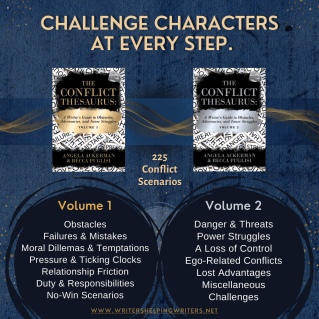 Need More Help
Need More HelpUnleashing the
Power of Conflict?
The Conflict Thesaurus: A Writer���s Guide to Obstacles, Adversaries, and Inner Struggles Volume 1 & 2 are packed with ideas on how to make conflict work harder in your story. Find out more.
The post How to Stay Focused on Your Story���s Central Conflict�� appeared first on WRITERS HELPING WRITERS��.
July 29, 2023
Character Type and Trope Thesaurus: Benefactor
In 1959, Carl Jung first popularized the idea of archetypes���”universal images that have existed since the remotest times.” He posited that every person is a blend of these 12 basic personalities. Ever since then, authors have been applying this idea to fictional characters, combining the different archetypes to come up with interesting new versions. The result is a sizable pool of character tropes that we see from one story to another.
Archetypes and tropes are popular storytelling elements because of their familiarity. Upon seeing them, readers know immediately who they’re dealing with and what role the nerd, dark lord, femme fatale, or monster hunter will play. As authors, we need to recognize the commonalities for each trope so we can write them in a recognizable way and create a rudimentary sketch for any character we want to create.
But when it comes to characters, no one wants just a sketch; we want a vibrant and striking cast full of color, depth, and contrast. Diving deeper into character creation is especially important when starting with tropes because the blessing of their familiarity is also a curse; without differentiation, the characters begin to look the same from story to story.
But no more. The Character Type and Trope Thesaurus allows you to outline the foundational elements of each trope while also exploring how to individualize them. In this way, you’ll be able to use historically tried-and-true character types to create a cast for your story that is anything but traditional.
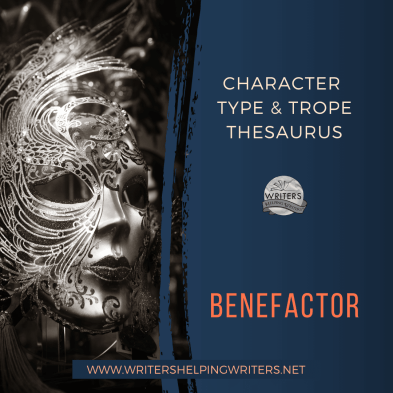 Benefactor
BenefactorDESCRIPTION: This character takes the protagonist under their wing with the aim of helping them succeed. This aid often comes in the form of gifts, such as a monetary contributions, providing a place of shelter, or paying for necessary schooling or training.
FICTIONAL EXAMPLES: Magwitch (Great Expectations), Aunt Josephine March (Little Women), James Hobart (The Goldfinch), Dan Cody (The Great Gatsby)
COMMON STRENGTHS: Ambitious, Appreciative, Cautious, Confident, Decisive, Discreet, Generous, Idealistic, Independent, Kind, Optimistic, Passionate, Protective, Quirky, Resourceful, Sophisticated, Supportive
COMMON WEAKNESSES: Controlling, Extravagant, Haughty, Hypocritical, Manipulative, Martyr, Materialistic, Needy, Obsessive, Possessive, Pretentious, Pushy, Resentful, Self-Indulgent, Stubborn, Temperamental, Vain
ASSOCIATED ACTIONS, BEHAVIORS, AND TENDENCIES
Being helpful
Wanting to do good things with their resources
Being generous
Offering to pay for things
Seeing the potential in ideas and people
Being optimistic
Enjoying the finer things in life (good meals, nice clothes, etc.)
Being culturally sophisticated
Controlling people through their money and/or influence
Seeing their contributions as investments
Vetting people and organizations carefully before aligning with them
Sharing their knowledge and expertise with others
Cultivating a public persona
Feeling strongly about a cause
Wanting to be a rescuer
Enjoying being needed
Believing money can solve most problems
Giving conditionally, with strings attached
Giving as a way of gaining love, acceptance, or power
Believing their “generosity” should automatically engender respect and esteem
Making a show of spreading their wealth around
SITUATIONS THAT WILL CHALLENGE THEM
Being generous with someone who doesn’t appreciate it
Supporting someone (or a cause) who turns out to be dishonest or even criminal
Losing all their money
Being blackmailed
Getting too personally involved in a cause so it clouds their judgment
Wanting to support several causes but only having resources for a few
Losing control of the cause or person they’re supporting
The motives behind their philanthropy (their character) being questioned
INNER STRUGGLES TO GIVE THEM DEPTH
Being philanthropic to try and make up for past wrongs, but it doesn’t work
Becoming aware of ulterior motives for wanting to help others (because it makes people like them, it makes up for other shortcomings, etc.)
Searching for a deeper purpose in life
Suspecting they’re being manipulated or played by a recipient
Learning about a worthy situation that would require a great sacrifice, and being unwilling to make it
Wanting to live vicariously through the person they’re supporting
Doubting the true motives of friends, family members, and associates; suspecting those people are there because of the benefactor’s wealth
Believing that giving in secret is the right thing to do but wanting the recognition that comes with giving publicly
TWIST THIS TROPE WITH A CHARACTER WHO���
Only gives anonymously
Has a quirky or eccentric hobby
Comes from an unusual cultural background
Is young
Is a benefactor to others but a miser at home with their own family
Has an atypical trait: paranoid, vindictive, whimsical, worrywart, simple, etc.
CLICH��S TO BE AWARE OF
The benefactor who starts out selfish and undergoes a significant transformation
The benefactor-mentor who has is wise and all-knowing and has all the answers
A benefactor who shows up at precisely the time they’re needed (deus ex machina)
The one-dimensional benefactor with no recognizable flaws
Other Type and Trope Thesaurus entries can be found here.
 Need More Descriptive Help?
Need More Descriptive Help?While this thesaurus is still being developed, the rest of our descriptive collection (16 unique thesauri and growing) is accessible through the One Stop for Writers THESAURUS database.
If you like, swing by and check out the video walkthrough for this site, and then give our Free Trial a spin.
The post Character Type and Trope Thesaurus: Benefactor appeared first on WRITERS HELPING WRITERS��.
July 27, 2023
After the First Draft: Revising Your Plot
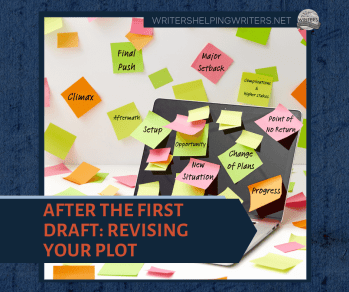
Ok, writers. Raise your hand if you love revising.
*crickets*
Revision freaks a lot of people out because it can be overwhelming. When you start drafting, you���ve got this really clear image of what the story should be, and by the time you type ���The End,��� it���s hardly recognizable. It���s a mess, and you���re not even sure what the problems are, much less where to start.
This is why I���m a fan of breaking the revision process into rounds���one for characters, one for plot, one for theme, pacing, polishing, etc. And in my experience, it���s the plot round that sends people running, because plotting and story structure aren���t simple.
But like most problems in life, I���ve found that a system can help de-terrify the process and make it manageable. And the first part of that process is addressing what I believe are the two most important questions.
Does Your Story Follow the 3-Act Structure?There are a dozen different ways for structuring a story and they���re all slightly different, but the majority of them are based on the 3-act structure. Why? Because it works, regardless of genre, audience, or author experience. This is why it���s been around in various storytelling forms for millennia.
The 3-act structure ensures that you���ve included the important story events and they happen at the right times. This design provides a framework for your story that keeps it from sagging, dragging, or jarring the reader and ensures that things are happening in a logical way. If you���re looking for a simple structuring tool, check out One Stop for Writers��� Story Maps, which is based on Michael Hauge’s excellent 6-plot story structure model:

(As an example of how this tool can help you structure your story, you can see here how we used it to map out the movie A Few Good Men.)
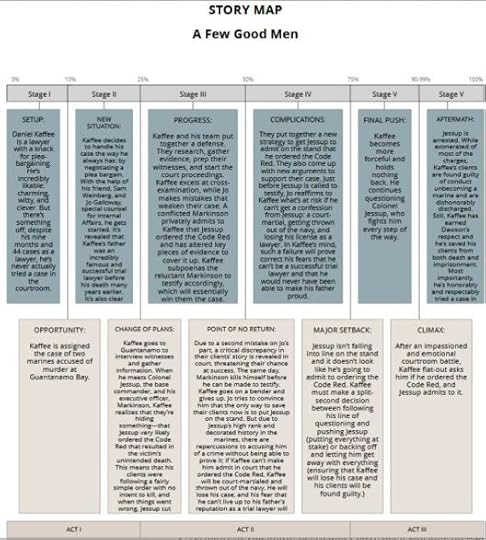
Now, there are other plotting methods, as well as authors who write with no method at all. And if you���ve mastered those processes with great success, rock on. But most people need a framework to keep their story on track. If you know your work in progress has issues but you���re not sure what they are, take some time to research the 3-act structure. Read up on Joseph Campbell���s The Hero���s Journey, familiarize yourself with Syd Field���s work, or check out popular plotting methods like Save the Cat to better understand how your story should be assembled.
Are the Important Events Happening at the Right Times?Structure works because it provides architecture for the story. Without it, we end up spending way too much time in the Setup or not enough in the Complications and Higher Stakes portion of the story. The pace is jerky or dragging; it lacks flow, and readers just can���t get into it. To remedy this, map out your important story events and see where they fall. Use Michael Hauge’s structure model to plug in your important story moments and see if they’re falling at the right spots. Compare that to your story and adjust your points as needed.
Once you���ve ensured that your story is structured properly, it���s time to examine the individual building blocks for potential issues. Remember that feeling of I know something���s wrong, but I don���t know what it is? This is where the pieces click into place.
Use the checklist that follows to review each stage of your story. If any of the answers are No, make the necessary changes to that part.
While I���ve referenced Michael Hauge���s plotting method here, I���ve included terms from models you might be more familiar with, along with a brief description of each stage���s purpose. And for simplicity���s sake, I���ve chosen to focus on plotlines for a character undergoing a change (positive) arc, since this is the kind we see most often. Does every hero have to experience this change? No, though I personally feel that most stories are stronger when an internal arc mirrors the outer journey. If this isn���t the case for your hero, just ignore the points having to do with inner change.
PLOT REVISION CHECKLISTACT I
Setup /Opening Scene/The Ordinary World: The first 10% or so of the story that introduces readers to the heroHave you shown the hero in their real world so readers will see the contrast when things change in a short period of time?Have you hinted at the hero being stuck or dissatisfied in some way? This is usually tied to their inner motivation���the why behind their visible story goal.Have you adequately developed reader empathy for the hero by making them likable, relatable, wounded, etc.?Turning Point #1/The Inciting Incident: A choice or opportunity that, if taken, will catapult the hero into a new worldIs there a clear choice for the hero to make?Is it related (but not necessary equal) to what will become their outer motivation, or overall goal, for the story?New Situation/Refusal of the Call/Debate: The hero gets acquainted with their new situationIf the hero accepted the call, are they getting to know the way things work in this new normal?Optional: Does the character move into a new environment? This isn���t required but can be an effective way to show them physically moving into a new situation.If the hero is waffling about the call or has rejected it altogether, are they doubting their decision or debating which way to go?Turning Point #2/Break into Two/Crossing the Threshold: The character makes the decision that propels them toward achieving their story goalIf the hero was undecided about the call, have they decided to accept it?Is the decision the hero made at Turning Point 1 clarified into their specific outer motivation (if it wasn���t before)?Is the goal something they can���t achieve without making specific internal changes (overcoming a flaw, facing a fear, dealing with an unresolved emotional wound, etc.)?Does the character make this decision purposefully, as opposed to being tricked or falling into it accidentally?ACT 2
Progress/Fun and Games: The hero begins actively pursuing their outer motivationDoes the hero have a plan for achieving their goal?Is the hero making steady progress (despite ample conflict and minor regressions)?As they pursue their outer goal, are they toying with making the necessary internal changes without being fully committed to doing so?Turning Point #3/Point of No Return/ Midpoint : The middle of the story, where the hero commits unequivocally to the goal���no more holding back or hedging their betsDoes the hero get an inkling (or a full-blown premonition) of what life would be like if they fully embraced the internal changes that need to be made?Does the hero take an action or make a statement that declares their intention to others, making it virtually impossible to turn back?Will that moment directly result in more complications and higher stakes (which will show up in the next stage)?Complications and Higher Stakes/Bad Guys Close In: Conflicts escalate and the stakes get higherAre the conflict scenarios intensifying?Have the stakes gotten higher and/or become more personal?Does the pace accelerate through this section instead of losing momentum?Are there opportunities for the hero to embrace inner change and turn away from the old habits that are no longer working?Optional: Is there a moment at the end of this stage when success seems to be a sure thing?Turning Point 4/Major Setback/All is Lost: The moment when the hero is at their lowest point and the goal seems out of reachDoes something critical happen that destroys the hero���s chance of achieving their dream?Optional: Does your turning point have an actual ���whiff of death��� to symbolize the death of the hero���s dream? To quote Blake Snyder, ���At the All Is Lost moment, stick in something, anything, that involves death. Whether it���s integral to the story or just something symbolic, hint at something dead here. A flower in a pot. A goldfish. News that a beloved aunt has passed away���.It���s where the old character, the old way of thinking dies.���ACT 3
Final Push/Dark Night of the Soul: In their darkest moment, the hero retreats from the objective, then rallies to put everything on the table in a last ditch effort to achieve the goalDoes the hero temporarily turn away from their goal, retreating back to the old ideas, behaviors, or coping mechanisms they were relying on at the start of the story?Does the hero then turn back to the goal���this time, all-in, with 100% dedication?From that point on, is the conflict relentless and almost overwhelming?Climax/Finale: The hero figures out what has to be done and makes it happenDo they make the necessary internal changes that will allow them to achieve their outer motivation and live in fulfillment?Does the hero face their biggest antagonist or overcome their biggest obstacle (often in a showdown kind of situation)?Do they achieve their outer motivation?Aftermath/Final Image/Return with the Elixir: The hero is living their new reality, fully realized, having achieved their goalDoes the aftermath mirror the setup in some way, showing the contrast of the character now vs. then?Have all plotlines and subplots been resolved by this point?STORY-WIDE CONSIDERATIONS
(borrowed and summarized from Michael Hauge���s Writing Screenplays that Sell)
 Does every scene, event, and character contribute to the hero���s outer motivation (getting them one step closer or taking them farther from it)? Have you created peaks and valleys along the way���humor, times of bonding, etc.���to break up intensity? Alternatively, in a humorous or light-hearted story, are there some serious moments?Have you surprised the reader here and there? Remember, you���re shooting for anticipation, not predictability.Have you generated questions for readers that will pique their interest and keep them reading?Have you carefully crafted your story elements (your hero, their relationships, the world you���ve created) so there are no inconsistencies that will undermine your credibility and pull readers out of the flow?Have you included a deadline or ticking clock as a way of increasing the stakes? This isn���t a necessity, but it almost always helps.
Does every scene, event, and character contribute to the hero���s outer motivation (getting them one step closer or taking them farther from it)? Have you created peaks and valleys along the way���humor, times of bonding, etc.���to break up intensity? Alternatively, in a humorous or light-hearted story, are there some serious moments?Have you surprised the reader here and there? Remember, you���re shooting for anticipation, not predictability.Have you generated questions for readers that will pique their interest and keep them reading?Have you carefully crafted your story elements (your hero, their relationships, the world you���ve created) so there are no inconsistencies that will undermine your credibility and pull readers out of the flow?Have you included a deadline or ticking clock as a way of increasing the stakes? This isn���t a necessity, but it almost always helps.This checklist isn���t exhaustive, but it should clarify for you which events, stages, and turning points aren���t pulling their weight. Even if you���ve used a different model that incorporates the 3-act structure, you should be able to verify that story events are happening in the right spots and are accomplishing their purposes.
Either way, having a plan for analyzing your story���s structure will help you find any trouble spots and provide support for your plot. So, no more crickets when it comes to revisions. Jump in with both feet (and your handy checklist) and own this part of the process.
The post After the First Draft: Revising Your Plot appeared first on WRITERS HELPING WRITERS��.
July 24, 2023
Improve Your Storytelling in 5 Minutes
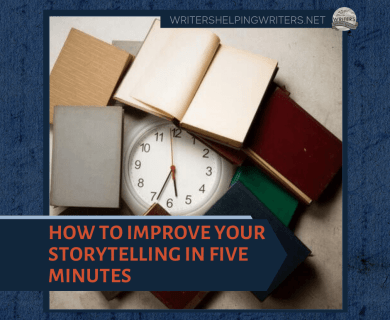
What are writers chronically short on? Time.
There never seems to be enough of it as we try to get the next book written, research our publishing options, keep up with marketing, work on our platform, etc., and that doesn’t even factor in what’s happening in other areas of our life. And as we juggle, the one thing that can help us succeed more than anything else is often neglected: education to help us improve our storytelling skills.
Introducing Mini-LessonsYou guys know Becca and I have a lot to say about description and how showing the right things in the right way means readers are pulled in and will care deeply about characters and what’s happening in their lives. We’ve written books on many description elements, and have even more of these in our THESAURUS database at One Stop for Writers.
This summer, Becca and I have recorded a mini lesson for each of our thesauruses, helping you better understand that story element, what its superpower is in your story, and how to activate that detail through description.
Each video takes you through a thesaurus in the One Stop for Writers database, but you don’t need to be a subscriber benefit from these lessons, or use our thesauruses (although they are very helpful for brainstorming). But if you are someone who uses them, this will broaden your understanding so you get even more value from each brainstorming list.
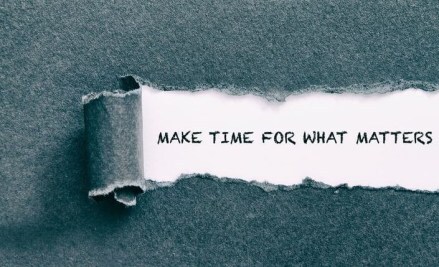 Summer is the perfect time for bite-sized learning
Summer is the perfect time for bite-sized learningSummer tends to be slower paced, as it should be. So, if you have 5 (ish) minutes, give a video a try. Whether you want to learn how to describe a character’s emotions, activate the power of your scene’s setting, or understand character motivation better so plotting becomes easier, a helpful mini lesson is waiting for you.
Here’s the playlist, or choose the topic you’d like to know more about below.
Happy writing, and learning!
Grow Your Skills with Becca & Angela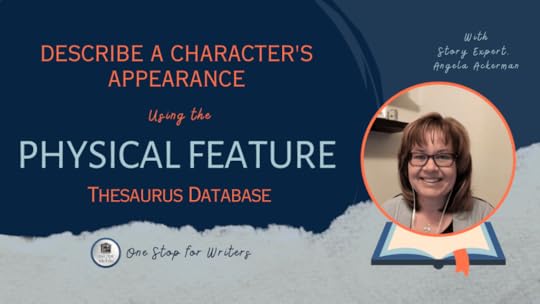 How to Describe a Character’s Appearance
How to Describe a Character’s Appearance
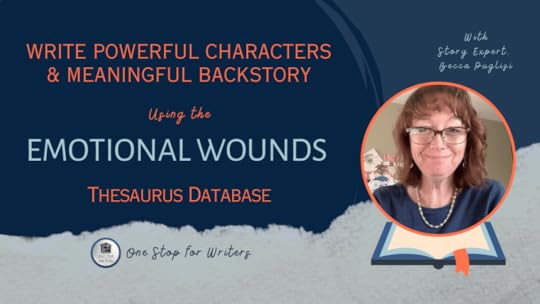 How Emotional Trauma Affects Characters & Their Arc
How Emotional Trauma Affects Characters & Their Arc
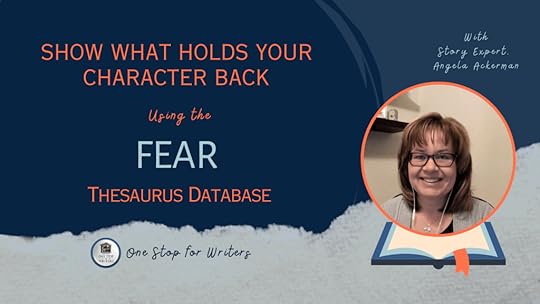 How to Use a Character’s Fears in Storytelling
How to Use a Character’s Fears in Storytelling
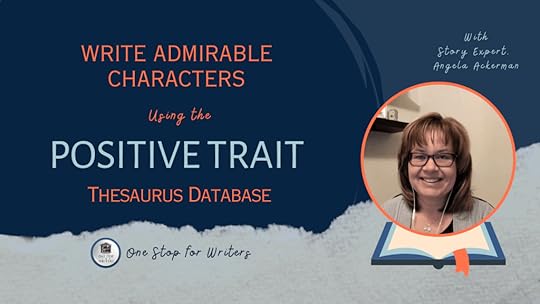 How to Create a Character Readers Will Love
How to Create a Character Readers Will Love
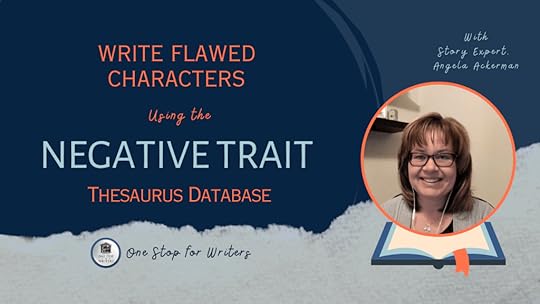 How to Give a Character Flaws that Will Hold Them Back
How to Give a Character Flaws that Will Hold Them Back
 How the Right Setting Details Make a Scene More Powerful
How the Right Setting Details Make a Scene More Powerful
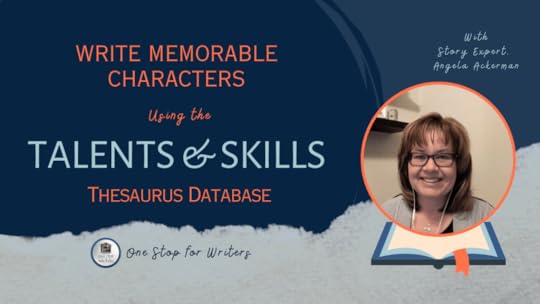 How to Create a Memorable Character Using a Talent or Skill
How to Create a Memorable Character Using a Talent or Skill
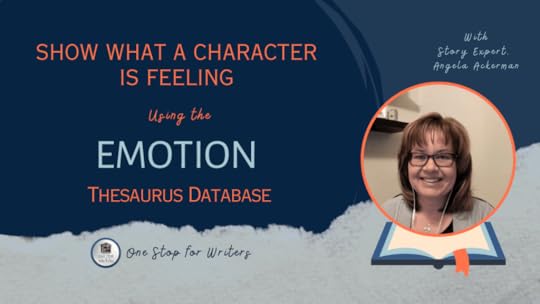 How to Show What Your Character Is Feeling
How to Show What Your Character Is Feeling
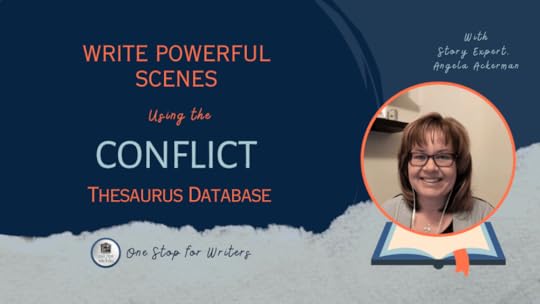 How to Use Conflict to Power up Your Story
How to Use Conflict to Power up Your Story
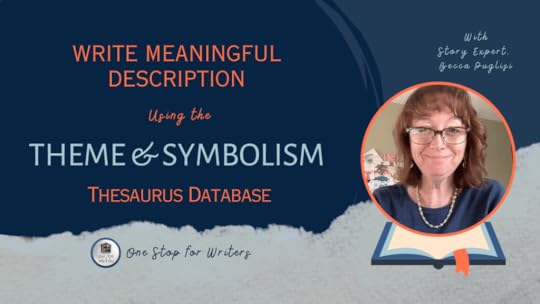 How to Write Your Theme and Use Effective Symbolism in Fiction
How to Write Your Theme and Use Effective Symbolism in Fiction
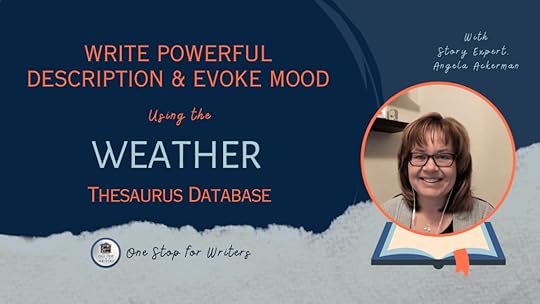 How to Use the Weather to Build Mood and Generate Conflict
How to Use the Weather to Build Mood and Generate Conflict
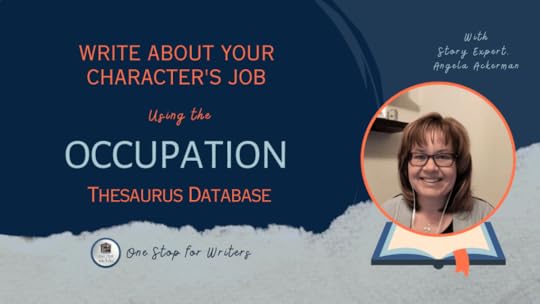 How to Find the Right Job for a Character
How to Find the Right Job for a Character
 How to Bring Readers Into a Story Using Textures
How to Bring Readers Into a Story Using Textures
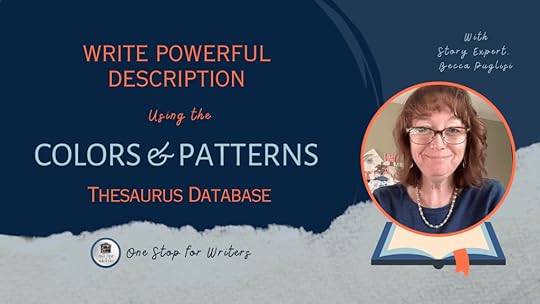 How to Create Vivid Description Using Colors and Patterns
How to Create Vivid Description Using Colors and Patterns
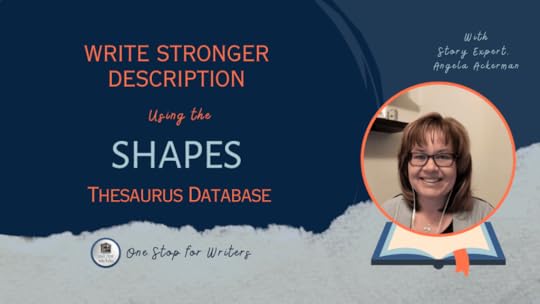 How Describing an Object’s Shape the Right Way Strengthens the Story
How Describing an Object’s Shape the Right Way Strengthens the Story
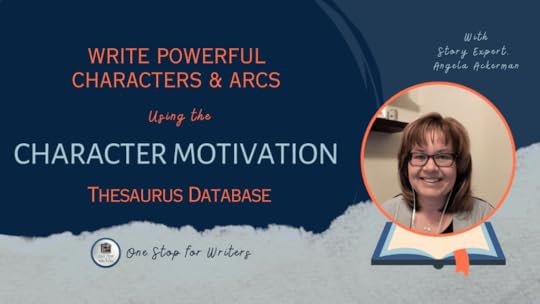 How to Build Strong Characters & Arcs
How to Build Strong Characters & Arcs
 How to Amplify Your Character’s Emotional State
How to Amplify Your Character’s Emotional State Need more help as you plan, write, and revise? Join us at One Stop!
Need more help as you plan, write, and revise? Join us at One Stop!The post Improve Your Storytelling in 5 Minutes appeared first on WRITERS HELPING WRITERS��.
July 22, 2023
Character Type and Trope Thesaurus: Hopeless Romantic
In 1959, Carl Jung first popularized the idea of archetypes���”universal images that have existed since the remotest times.” He posited that every person is a blend of these 12 basic personalities. Ever since then, authors have been applying this idea to fictional characters, combining the different archetypes to come up with interesting new versions. The result is a sizable pool of character tropes that we see from one story to another.
Archetypes and tropes are popular storytelling elements because of their familiarity. Upon seeing them, readers know immediately who they’re dealing with and what role the nerd, dark lord, femme fatale, or monster hunter will play. As authors, we need to recognize the commonalities for each trope so we can write them in a recognizable way and create a rudimentary sketch for any character we want to create.
But when it comes to characters, no one wants just a sketch; we want a vibrant and striking cast full of color, depth, and contrast. Diving deeper into character creation is especially important when starting with tropes because the blessing of their familiarity is also a curse; without differentiation, the characters begin to look the same from story to story.
But no more. The Character Type and Trope Thesaurus allows you to outline the foundational elements of each trope while also exploring how to individualize them. In this way, you’ll be able to use historically tried-and-true character types to create a cast for your story that is anything but traditional.
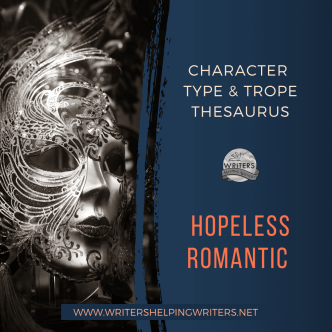 Hopeless Romantic
Hopeless RomanticDESCRIPTION: Hopeless romantics love being in love and are eternally optimistic in the quest to find their soulmate. When that quest is born from an unmet need or past wounding event, it can become all-consuming, prioritized above everything (and everyone) else.
FICTIONAL EXAMPLES: Marianne Dashwood (Sense and Sensibility), Romeo and Juliet (Romeo and Juliet), Jay Gatsby (The Great Gatsby), Giselle (Enchanted), Joan Wilder (Romancing the Stone)
COMMON STRENGTHS: Affectionate, Charming, Enthusiastic, Extroverted, Flirtatious, Friendly, Funny, Generous, Happy, Idealistic, Kind, Passionate, Perceptive, Persistent, Persuasive, Sensual, Sentimental, Trusting, Whimsical
COMMON WEAKNESSES: Addictive, Flaky, Gullible, Impatient, Impulsive, Insecure, Irrational, Jealous, Manipulative, Melodramatic, Needy, Obsessive, Oversensitive, Possessive, Self-Indulgent, Temperamental, Weak-Willed, Whiny
ASSOCIATED ACTIONS, BEHAVIORS, AND TENDENCIES
Having a clear idea of who their perfect match should be
Always being on the lookout for someone who could be their soulmate
Noticing the little things about other people
Having a cheerful disposition
Believing in signs and destiny
Being gushy and/or over-emotional
Always thinking the best of a love interest
Being open-minded
Having creative hobbies and passions
Being willing to compromise and make sacrifices
Enjoying going out and being social
Always looking on the bright side and finding silver linings
Making dramatic gestures
Being affectionate
Spontaneity
Being idealistic about love and romance
Making direct eye contact with people
Being too trusting of people’s intentions
Being so devoted to their lover that they marginalize or abandon other people
Living in their head
Forgiving others to the point of being taken advantage of
Being distracted from too much daydreaming
Feeling incomplete when they’re not in a relationship
Allowing a relationship to take over their lives
Losing themselves in the person they’re with
Throwing themselves recklessly into a relationship
SITUATIONS THAT WILL CHALLENGE THEM
Falling in love with someone they shouldn’t (someone who’s married, an abuser, isn’t interested in long-term relationships, etc.)
Unrequited love
Being dumped by someone the character thought was “the one”
Close friends getting married while the character remains single
Being offered their dream job in another city (away from the one they love)
Learning information they must share with their beloved that’s guaranteed to drive them away
Being rejected by their partner’s family
Attracting someone dangerous
Loving someone the character’s family doesn’t approve of
Being pushed by friends to date a “perfect match” the character isn’t drawn to
INNER STRUGGLES TO GIVE THEM DEPTH
Struggling with loneliness
Feeling insecure because they can’t find a partner
Believing that only one person can make them happy, and despairing of finding that person
Worrying that they’ve “settled” for the person they’re with
Being dumped and struggling with sadness or depression
Realizing the person they’re with is bad for them but not wanting to be alone
Wanting to hurt the person who’s broken their heart
TWIST THIS TROPE WITH A CHARACTER WHO���
Is street smart and savvy
Is romantic until things go wrong, at which point she becomes vindictive
Has trouble getting along with others
Is wildly successful in another area of life
Has an atypical trait: introverted, controlling, know-it-all, suspicious, meticulous, etc.
CLICH��S TO BE AWARE OF
The hopeless romantic embroiled in a stereotypical love triangle, such as the plain girl, her best friend, and a hot guy at school
The romantic character who falls in love with someone at first sight
The romantic who believes they have just “one true love” and they must find that person
Hopeless romantics who are na��ve, gullible, and innocent
The romantic whose desperation to find love lands her in one bad relationship after another
Other Type and Trope Thesaurus entries can be found here.
 Need More Descriptive Help?
Need More Descriptive Help?While this thesaurus is still being developed, the rest of our descriptive collection (16 unique thesauri and growing) is accessible through the One Stop for Writers THESAURUS database.
If you like, swing by and check out the video walkthrough for this site, and then give our Free Trial a spin.
The post Character Type and Trope Thesaurus: Hopeless Romantic appeared first on WRITERS HELPING WRITERS��.
July 19, 2023
Phenomenal First Pages Contest
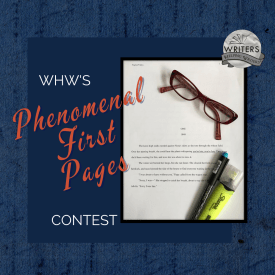 Hey, wonderful writerly people! It���s time for our monthly first-page critique contest
Hey, wonderful writerly people! It���s time for our monthly first-page critique contest  How to enter:
How to enter:Leave a comment if you���re working on a first page (in any genre except erotica) and would like some objective feedback. As long as the email address associated with your WordPress account/comment profile is up-to-date, I���ll be able to contact you if your first page is chosen. Just please know that if I���m unable to get in touch with you through that address, you���ll have to forfeit your win.
Two caveats:
 Please be sure your first page (double-spaced in 12-point font) is ready to go so I can critique it before next month���s contest rolls around. If it needs some work and you won���t be able to get it to me right away, let me ask that you plan on entering the next contest, once any necessary tweaking has been taken care of.
Please be sure your first page (double-spaced in 12-point font) is ready to go so I can critique it before next month���s contest rolls around. If it needs some work and you won���t be able to get it to me right away, let me ask that you plan on entering the next contest, once any necessary tweaking has been taken care of.
 This contest only runs for 24 hours, start to finish, so get your comment in there!
This contest only runs for 24 hours, start to finish, so get your comment in there!
Three commenters��� names will be randomly drawn and posted tomorrow morning. If you win, you can email me your first page and I���ll offer my feedback.
We run this contest on a monthly basis, so if you���d like to be notified when the next opportunity comes around, consider subscribing to our blog (see the right-hand sidebar).
Best of luck!
PS: If you want to amp up your first page, grab our helpful First Pages checklist from One Stop for Writers. And for more instruction on these important opening elements, see this Mother Lode of First Page Resources.
The post Phenomenal First Pages Contest appeared first on WRITERS HELPING WRITERS��.
July 18, 2023
Keep Tensions High by NOT Resolving Your Character���s Relationship Conflict
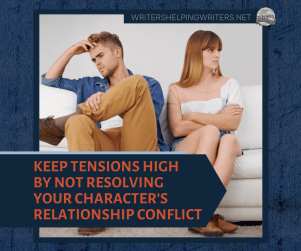
When it comes to story conflict, there are so many options to choose from. Power struggles, physical threats, moral dilemmas, failures, ticking clocks���they���re all great for ratcheting up tension, building reader empathy, and strengthening our plotlines. But the conflict we face most often as human beings���the kind that hits closest to home for our characters���is relationship friction. It happens on the daily and comes in a variety of shapes and sizes:
Condescending co-workersPassive-aggressive neighborsInconsiderate shoppers at the grocery store Relatives with strong political viewsA rivalry with a romantic competitorPeer pressureBreak-upsEtc.Relationship conflict is great for your story because it���s such a natural part of the human experience; chosen thoughtfully, these scenarios will fit seamlessly into your character���s world. And while a lot of conflict can be ignored or pushed aside, relationship friction just screams to be resolved because it���s personal and in the character���s face���especially when it involves someone who can���t or won���t be avoided.
But this creates another problem, because we know that strong stories need tension, and the only way you get that is with conflict. So you don���t want your character handling their people problems too efficiently. Not that they shouldn���t try … it’s just best for the story if they fail.
How do you ensure your protagonist doesn���t succeed in their attempts at reconciliation?
Here are a few disruptors you can employ to keep the conflict going.
How many times have you gotten to the other side of a problem with a friend or loved one before realizing that a simple misunderstanding was to blame? And how much easier would it have been if both parties had been concise and clear to begin with? Misunderstandings and imprecise communication are the cause of a lot of conflict. So if your character is trying to work through an issue with an opponent, manufacture a misunderstanding. Ambiguous language could result in one person interpreting the meaning of something differently than it was intended, and assumptions can take your character down the wrong track.
An Unwillingness to Accept Responsibility
When conflict arises, most characters will focus on how it impacted them and how they were wronged. But each party will typically bear some responsibility for the situation. Even when one person carries more guilt than the other, for a breach to be mended, both parties need to take a breath and acknowledge how they could have responded differently, been more considerate, or tried harder. If either person is unwilling to go that far, peace talks can stall.
A New Issue Cropping UpPerhaps your characters are doing everything right to fix their issue. They’re being clear in their communication and have analyzed and admitted responsibility for the part they played. Things are going swimmingly���until something happens that creates a new issue.
This is done beautifully in a scene from A Few Good Men. Daniel Kaffee and his legal team go to Guantanamo Bay to meet with some high-level, high-ego officers. These are powerful men who aren’t happy with the case, but their cooperation is vital, so Kaffee needs to smooth things over. He makes it through lunch and is almost in the clear when he asks for a document Jessup doesn’t want to provide. And it all hits the fan. They’re right back to where they started.
One benefit of this technique is that it allows your character to almost defuse the original conflict. The tension, which was high, starts shifting downward, and then���bam! It’s elevated again. Give your character a win, then hit them again from an unexpected quarter to heighten the stress and keep readers guessing.
Personality ConflictsPeople are unique, with their own styles of communicating, behaving, and interacting. But not all personalities get along. One person’s teasing to lighten the mood might cause another���s prickly nature to emerge, or a reserved character���s quiet response may come across as passive or uncooperative to someone else. When opposites don’t attract, they’re likely to rub each other wrong, lessening the chance of the original conflict being resolved.
Biases and Personal History

The more history your character has with the other person, the more complicated the situation will be. They have this recent snag to work through, but past experiences and their own feelings will cloud the issue.
Encourage this scenario by setting the stage for readers. Make them aware of a significant blow-up in the past or that conflict with this person is an ongoing thing. Use your character’s internal dialogue to show their judgment or bias about the other party. Then, when the two run into each other and attempt to make up, their preconceptions and history will tank the effort before it gets off the ground.
Half-Hearted Attempts
A realistic response to conflict is the half-hearted one because, honestly, characters don’t always want to fix things. Maybe they’re being bullied into reconciliation by a third party or they they���re making the attempt because they know they should (but they don���t really want to resolve the issue). In these situations, the character will make a perfunctory attempt that’s sure to fail���prolonging the tension but also providing a confrontation that will generate more problems.
Avoidance
When it comes to dragging out conflict, this is the most obvious choice. Most people hate confrontation and put it off as long as possible. And we know what happens when problems aren���t dealt with: they fester, and complications multiply, making things worse.
The act of avoidance itself can generate conflict as the character goes to great lengths to keep from facing the issue. This technique gets high points for both authenticity and its tendency to create more issues, so if avoidance fits your character���s personality, take advantage of it.��
In short, once you���ve written your character into a confrontation with a loved one, co-worker, friend, or teammate, don���t let them off the hook. Use any means necessary to prolong the agony. A great way to do this is to mine your own experience. Think back to altercations you���ve had that dragged on longer than they should have. What actions or omissions (your own or the other party���s) kept the situation from resolving? Add those missteps to this list and you���ll have many options for increasing your character���s relationship turmoil.
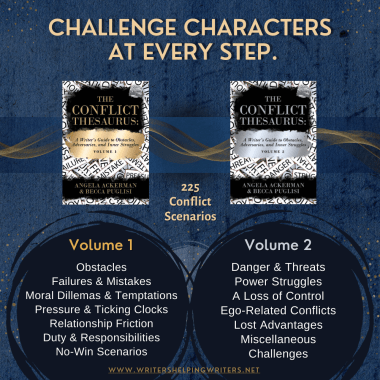 Want to take your conflict further?
Want to take your conflict further? The Conflict Thesaurus: A Writer’s Guide to Obstacles, Adversaries, and Inner Struggles (Volume 1 & Volume 2) explores a whopping 225 conflict scenarios that force your character to navigate relationship issues, power struggles, lost advantages, dangers and threats, moral dilemmas, failures and mistakes, and much more!
The post Keep Tensions High by NOT Resolving Your Character���s Relationship Conflict appeared first on WRITERS HELPING WRITERS��.
July 15, 2023
Character Type and Trope Thesaurus: Grotesque
In 1959, Carl Jung first popularized the idea of archetypes���”universal images that have existed since the remotest times.” He posited that every person is a blend of these 12 basic personalities. Ever since then, authors have been applying this idea to fictional characters, combining the different archetypes to come up with interesting new versions. The result is a sizable pool of character tropes that we see from one story to another.
Archetypes and tropes are popular storytelling elements because of their familiarity. Upon seeing them, readers know immediately who they’re dealing with and what role the nerd, dark lord, femme fatale, or monster hunter will play. As authors, we need to recognize the commonalities for each trope so we can write them in a recognizable way and create a rudimentary sketch for any character we want to create.
But when it comes to characters, no one wants just a sketch; we want a vibrant and striking cast full of color, depth, and contrast. Diving deeper into character creation is especially important when starting with tropes because the blessing of their familiarity is also a curse; without differentiation, the characters begin to look the same from story to story.
But no more. The Character Type and Trope Thesaurus allows you to outline the foundational elements of each trope while also exploring how to individualize them. In this way, you’ll be able to use historically tried-and-true character types to create a cast for your story that is anything but traditional.
 Grotesque
GrotesqueDESCRIPTION: A grotesque is a character whose deformities mask their likable personality and arouse pity and sympathy from others. They have extreme physical or behavioral features that can be unsettling, disturbing, or even repulsive. Because of this, grotesques can challenge preconceptions of what is beautiful and acceptable.
FICTIONAL EXAMPLES: Quasimodo (The Hunchback of Notre Dame), Frankenstein’s monster (Frankenstein), Erik/the Phantom (The Phantom of the Opera), the Beast (Beauty and the Beast), Edward Scissorhands (Edward Scissorhands)
COMMON STRENGTHS: Alert, Cautious, Creative, Curious, Focused, Independent, Intelligent, Introverted, Loyal, Observant, Passionate, Pensive, Perceptive, Persistent, Private, Quirky, Resourceful, Simple
COMMON WEAKNESSES: Antisocial, Callous, Compulsive, Hostile, Jealous, Judgmental, Morbid, Obsessive, Paranoid, Possessive, Resentful, Suspicious, Uncommunicative, Uncouth, Volatile, Withdrawn
ASSOCIATED ACTIONS, BEHAVIORS, AND TENDENCIES
Withdrawing from society and living an isolated life
Attempting to hide their deformity
Approaching new people and situations with caution
Expecting a negative reaction from new people
Obsessing about a person or ideal they perceive to be perfect
Obtaining a sense of connection by observing social interactions from a distance
Being alert to potential threats
Emotional volatility
Always keeping their guard up
Showing staunch loyalty to anyone who shows them kindness
Being possessive of a friend’s time and affection
Exhibiting extreme responses in socially awkward situations (shutting down, fleeing, lashing out physically, etc.)
Doggedly pursuing an objective that could soothe their pain
Making do with few resources
Having an active imagination and vibrant inner world
Fantasizing about what life would be like without their deformity
Being critical of others
Scorning the vanity of others
Suspecting that everyone is out to get them
Being slow to trust
Seeking revenge against those who have wronged them
Being driven to gain the advantages their deformity has denied them
Being morally corrupt
SITUATIONS THAT WILL CHALLENGE THEM
Discovering their actions have hurt someone they care about
Being approached by someone who seems to be seeking friendship or romance
Facing a new social environment full of strangers
Discovering their deformity has once again kept them from achieving a goal or gaining fulfillment
A friend going absent or radio silent
Being put on display or thrust into the limelight
INNER STRUGGLES TO GIVE THEM DEPTH
Feeling lonely and isolated but being too afraid to pursue relationships
Meeting someone who sees the beauty of the character’s soul but being unable to trust them
Wanting to meet a mentor’s expectations but lacking the tools to do so
Wanting to accomplish a greater purpose but being hampered by their deformity
Wondering if they’re being punished for their deformity���because of a past mistake, a character failing, etc.
Achieving public validation but not seeing themselves as worthy
Having to choose between gaining respect or doing the right thing
TWIST THIS TROPE WITH A CHARACTER WHO���
Is obsessed with their own appearance despite their deformity
Creates beautiful art or does a lot of good in the world
Looks out and cares for others who are also minimized by society
Cares more about doing the right thing than having people like them
Has an atypical trait: vain, courteous, ethical, bold, pretentious, sophisticated, etc.
CLICH��S TO BE AWARE OF
A grotesque whose physical deformity is used solely as a way to “other” them in the reader’s eyes
The character being “saved” by a romantic relationship
Tragic grotesques without agency to change anything about their life or situation
The grotesque as an irredeemable monster
Other Type and Trope Thesaurus entries can be found here.
 Need More Descriptive Help?
Need More Descriptive Help?While this thesaurus is still being developed, the rest of our descriptive collection (16 unique thesauri and growing) is accessible through the One Stop for Writers THESAURUS database.
If you like, swing by and check out the video walkthrough for this site, and then give our Free Trial a spin.
The post Character Type and Trope Thesaurus: Grotesque appeared first on WRITERS HELPING WRITERS��.
Writers Helping Writers
- Angela Ackerman's profile
- 1022 followers



